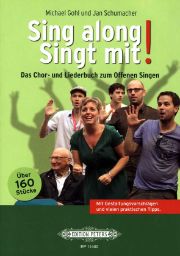Leading an open singing event?
"Sing along!", the choir and song book for open singing, not only offers plenty of material, but also methodology.

The authors Michael Gohl and Jan Schumacher, both well-known choral conductors of the highest caliber, present a publication on open singing that has what it takes to become a new standard work, or at least a compendium with a wealth of material for (almost) every need in this field. The sheet music section of the book is divided into six chapters: "Canons, Humor, Movement", "From all over the world", "Classical and Spiritual", "Advent and Christmas", "Gospels, Blues, Jazz" and "Rock, Pop, Schlager". These headings alone illustrate the great stylistic diversity and the ideology-free openness of the collection. At the same time, a good mixture of "old hits" and new or newly arranged songs has been found. The nature of the arrangements is also decidedly successful: most of them can be adapted for a wide variety of situations. The number of voices ranges from one to 41 (!).
Stylistically, the collection contains music from the 16th century to the present day. Popular music, which for most people today is the normal case of music, takes up a large part of it; one almost has to be grateful that the area of traditional choral music from the Renaissance to the Romantic period is also included in a clever selection. So-called world music also plays a major role - Africa, Latin America and various other regions of the world are richly represented musically.
If anything is missing, it is perhaps the area of "modernism". Even if this "naturally" does not appear to be automatically compatible with the area of open singing with musical amateurs, there have been and still are more recent or living composers who have consciously dealt with the specific requirements of such a situation. In addition to the almost complete absence of classical modern music here, it would perhaps also be conceivable to prepare conceptual music for open singing or to commission suitable composers to do so. Comparable to the arrangements for flexible situations that are available in abundance, improvisational scenarios could be created that leave tonal ties behind, but are still simple enough to be realized and thus enable truly new sound experiences. With the appropriate courage, a little more would have been possible here - after all, there are very occasional cautious steps in this direction.
The accompanying text section of the volume is very successful and helpful. In addition to the foreword and introduction to the task, the appendix contains a full-blown methodology of open singing, written by Michael Gohl. These fundamental notes, which reflect all the issues surrounding the topic, are absolutely worth reading and full of content, indeed they are basically a kind of small textbook - anyone who reads Gohl's thoughts carefully and puts them into practice will be equipped for any kind of open singing.
The volume is supplemented by a useful and clearly laid out table, which makes it extremely easy to consciously select songs for specific target groups. All in all, a well-rounded and well-done book that is recommended to anyone who is interested in open forms of singing.
Sing along! Sing along! The choir and songbook for open singing, edited by Michael Gohl and Jan Schumacher, EP 11400, € 29.95, Edition Peters, Leipzig et al. 2014









